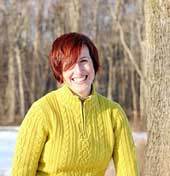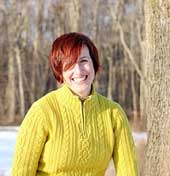 KINGSTON, R.I. – April 2, 2014 – Who among us hasn’t gazed upon a handmade quilt hanging on a friend’s wall – or the Smithsonian – and wondered how she did it, what with all those tiny squares and triangles.
KINGSTON, R.I. – April 2, 2014 – Who among us hasn’t gazed upon a handmade quilt hanging on a friend’s wall – or the Smithsonian – and wondered how she did it, what with all those tiny squares and triangles.
University of Rhode Island English teacher and graduate student Rachel May has some good news: If you can sew a straight line, you can quilt. And if you’re a creative soul – or want to be – then you can make a masterpiece.
In her new book, “Quilting with a Modern Slant: People, Patterns, and Techniques Inspiring the Modern Quilt Community,” May, of North Kingstown, encourages beginners to “pick up fabric and scissors, needle and thread” and sew something that reflects “your voice.”
“There are so many different ways of quilting,” she says. “You can draw from tradition, make up your own pattern, or dye your own fabric. That’s what allows you to make it your own.”
The modern quilting movement has been growing for decades. A founding member of the Boston Modern Quilt Guild, May says the movement allows quilters the freedom to play with tradition and take liberties with fabrics, patterns, colors, stitching and space. Some say it’s a hybrid of traditional quilting and quilting as art.
How-to tutorials with advice are scattered throughout the book. But the focus is on profiles of 80 quilters – traditional and art quilters, as well as modern ones – about how they quilt and, just as important, why they quilt.
Since the book was published in January, May has been touring the country, signing copies and meeting other quilters in what she describes as a vibrant community of mostly women from all backgrounds – engineers, lawyers, artists, and stay-at-home mothers.
“It’s been really fun,” she says. “Quilters bring their own work and talk about the process and ask a lot of questions. It’s inspiring to meet quilters from all over the country.”
May expected to sell 100 copies and call it a day. But 8,000 copies have been sold so far, enough to warrant a second printing. Her book tour took her to Seattle and Denver, and this summer she expects to visit Kansas City, Pittsburgh, and Charleston, S.C.
May’s mother taught her how to sew when she was a girl in Bolton, a small community outside Boston. She sewed some in her 20s, but embraced it in her 30s when she was living in Nebraska, where winters were “cold and quiet.” She made a wedding quilt for a friend with scraps from a fabric store and was hooked.
Back on the East Coast, she continued her quilting and started making what she calls fabric pictures – narratives made with fabric pieces. In one, for example, she’s portrayed as a girl looking out her bedroom window longing to play in a field of flowers outside.
She found the work meditative. “It’s really relaxing,” she says. “I can’t paint. I can’t draw. I feel like this is something I can do.”
In 2010, just before she started teaching creative writing and literature classes in URI’s English department, she came up with the idea for her quilting book. It took three years to write. The book has received rave reviews from critics and was even featured on the Martha Stewart Living blog.
Creative writing is May’s other passion. She has published 20 short stories and is working on a novel about three sisters and how their lives change after one sister is seriously hurt in an accident.
Writing a novel and quilting share a common thread, she says. “My novel is written in short pieces – short bits of prose. I wrote those as they came to me, and now I’m trying to figure out how to put them together. It sort of feels like piecing a quilt.”
May has won many writing awards, including two prestigious Pushcart Prize nominations. She is also editor of the Rhode Island-based literary journal, Ocean State Review.
At URI, she is pursuing a doctorate in English and cultural studies, with a focus on quilts and narrative. She’s researching a historic quilt in URI’s textile department that the Cushman family, an old Rhode Island family, worked on from 1830 to 1950.
Paper doubles as a pattern to make fabric shapes like hexagons. May is examining the writings on the Cushman’s paper patterns to discern their historic significance. Paper was in scarce supply then, so used sheets were cut up for quilting.
“I’m finding pieces of shipping records and references to rum and sugar in the West Indies,” she says. “I’m trying to figure out where all these scraps of paper came from and what they tell us about the family. It’s fascinating.”
For information about May’s book, visit Quilting with a Modern Slant. To see her fabric pictures, visit Fabric.
Pictured above: Rachel May, of North Kingstown, a teacher and graduate student in English and cultural studies at the University of Rhode Island. She wrote a book, “Quilting with a Modern Slant: People, Patterns, and Techniques Inspiring the Modern Quilt Community.” May has presented scholarly papers on quilting, including one at the Association of Cultural Studies in Paris.
Photo by Stacey Shrontz.

